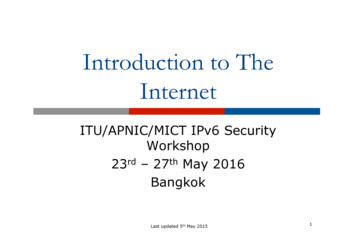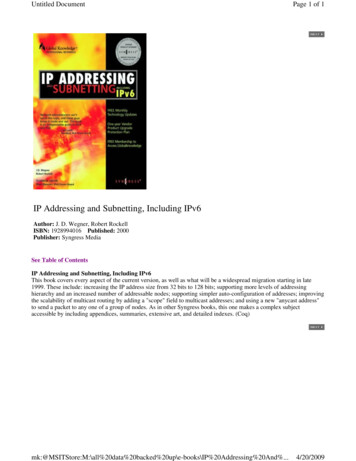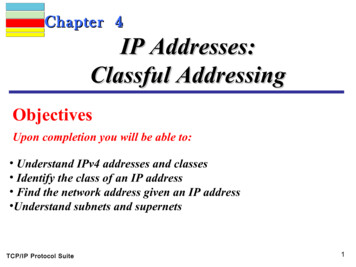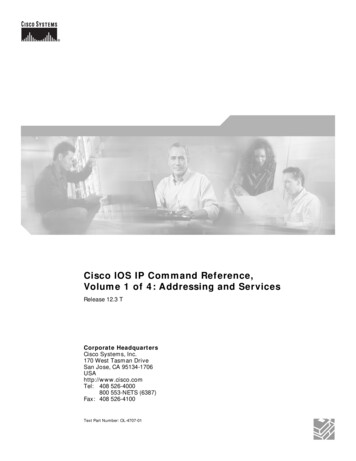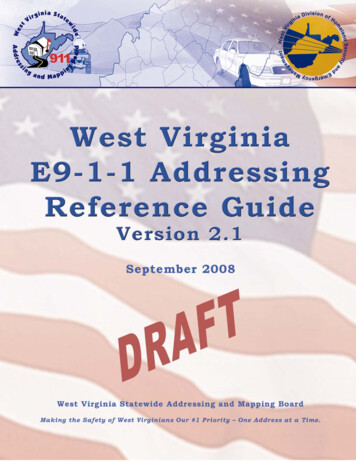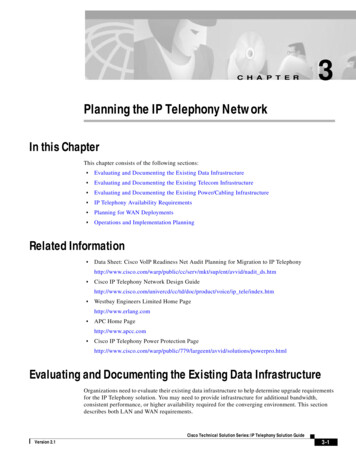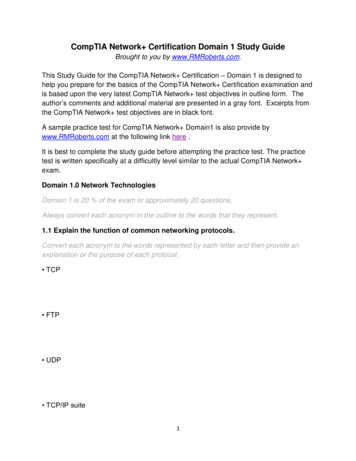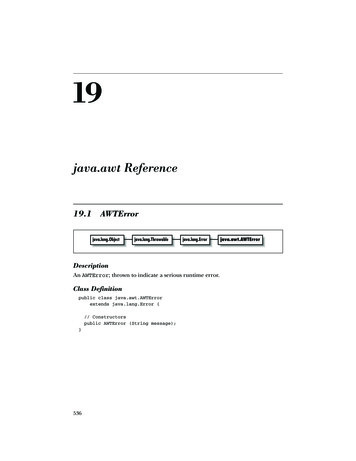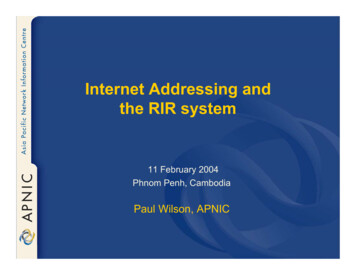
Transcription
Internet Addressing andthe RIR system11 February 2004Phnom Penh, CambodiaPaul Wilson, APNIC
Overview I What is an IP address?– What types of IP addresses are there? IP address management– Evolution of IP address management Introduction to APNIC– What is APNIC?
Internet Protocol AddressesWhat are they like andhow do they behave?
“On the Internet,nobody knows you’re a dog ”by Peter Steiner, from The New Yorker, (Vol.69 (LXIX) no. 20)
“On the Internet ”you are nothing but an IP w.dogs.biz209.217.36.32www.gnso.org199.166.24.5
Internet for everything!
What is an IP Address?
Overview What is an IP address?– and what it is not Internet address routing What is an IP address like?– IP address characteristics
What is an Address? An identifier which includes informationabout how to find its subject (according to some rules of interpretation) Normally hierarchical– Each part provides more specific detail For example – Room x, Level M, Sunway HotelPhnom Penh, Cambodia– www.itu.int– pwilson@apnic.net
What is an IP address? Internet identifier including informationabout how to reach a location(via the Internet routing system) IPv4: 32-bit* number– 4 billion different addresses available IPv6: 128-bit number– 340 billion billion billion billion addressesavailable For example – 202.12.29.142– 202.12.29/24(a computer)(APNIC’s network)* bit binary digit
Internet address routingThe InternetGlobal Routing Table4.128/960.100/1660.100.0/20135.22/16 202.12.29.0/24 29.0/24
Internet address routingTraffic202.12.29.142Local Routing TableLocal Router202.12.29.0/25202.12.29.128/25202.12.29.142
What else is an IP address? IP addresses are – Internet infrastructure addresses– a finite Public Resource– not “owned” by address users– not dependent upon the DNS IP does not mean “IntellectualProperty”
IP addresses vs domain namesThe InternetDNS202.112.0.46www.cernet.net ?202.12.29.142My Computerwww.cernet.net202.112.0.46
IP Address Characteristics
What is “my” address? IP Address Network interfaceaddress– Not a computer’s address– Nor a person’s addressModem?802.11IPv4LANIPv6
Is “my” address permanent? No - Customer addresses oftenchange– Dialup addresses are “dynamic” ISP132.234.250.31132.234.250.30
Is “my” address unique? Not necessarily – Public IP address unique– Private* IP address non-uniqueISP202.12.0.12961.45.100.13ISPNAT / firewall192.168.0.142192.168.0.0/24* RFC 1918
Summary so far IP Addresses identify location– Provide specific information for routing IP Addresses identify interfaces– Not computers, companies or users IP Addresses often change– And may not be unique
IP Address Management
Overview Early address managementEvolution of address managementAddress management todayAddress policy development
Address Management – pre 1992RFC 12611991RFC 10201987RFC 7901981“The assignment of numbers is also handled by Jon.If you are developing a protocol or application that willrequire the use of a link, socket, port, protocol, ornetwork number please contact Jon to receive anumber assignment.”
AddressManagement– 1990’sGlobal routingtable: ’88- ’929000 Early 1990’s: Internet scaling7000 problems6000 Address depletion80005000– due to classful architecture (A, B, C) Routing table overload40003000– Due to lack of route aggregation200010000Jul-88 Jan-89 Jul-89 Jan-90 Jul-90 Jan-91 Jul-91 Jan-92 Jul-92
Address Management – 1990’s Internet widely projected to fail– Growth would stop by mid-’90s– Urgent measures required– Action taken by IETF / Internet community 1993: Development of “CIDR” addressed both technical problems– Address depletion Through more accurate assignment– Routing table overload Through address space aggregationRFC1517RFC1518RFC1519
Classful & Classless addressingClassfulABC128 networks x 16M hosts16K networks x 64K hosts2M networks x 256 hostsObsolete inefficient depletion of B space too many routesfrom C Best CurrentPracticeClassful.1C.16 C32 C64 C128 C1B. Network boundaries may occur at any bit
Address Management – 1992 Administrative problems remained– Greater complexity of CIDR-based allocations– Increasing awareness of conservation andaggregation goals– Need for fairness and consistency RFC 1366 (1992)– Described the “growth of the Internet and itsincreasing globalization”– Additional complexity of address management– Set out the basis for a regionally distributedInternet registry systemRFC1366
Address Management – 1992 Establishment of RIRs– APNIC, ARIN, RIPE NCC (LACNIC later)– Regional open processes– Cooperative policy development– Industry self-regulatory model bottom upAPNICARINRIPE ACNICcommunity
Address Management – Today
Address Management – TodayIPv4 IPv6IANAAllocationRIRAllocationISPAssignmentUser
Where can I get IP addresses?/8APNICISP1. Allocation from APNIC/NIR (A)2. Sub-allocation from upstream ISP . Non-portable assignment from ISP (C)2. Portable assignment from APNIC (D)CDC/26end-user/24/24end-userend-userAssignments
Questions ?
What is APNIC?
What is APNIC? Regional Internet Registry (RIR)for the Asia Pacific Region– Regional authority for Internet Resourcedistribution– IP addresses (IPv4 and IPv6), AS numbers,reverse DNS delegation Established 1993– Operating within ICANN (IANA) structure– Pilot project of APNG in Tokyo, Japan– Relocated to Brisbane, Australia in 1998
About APNIC Industry self-regulatory body–Participation by those who need and useInternet resources–Consensus-based, open and transparent–Non-profit, neutral and independent Membership-based structure–Open to any interested party–Provides formal structure for cost recovery,election of representatives etc
APNIC mission statement“Addressing the challenge ofresponsible Internet resourcedistribution in the Asia Pacific region.”
What does APNIC do? Resource services– IPv4, IPv6, ASNs– Reverse DNS Policy coordination andimplementation– Open bottom-up, self-regulatory– Membership reviews and approves policy Resource registration– Authoritative server: whois
What else does APNIC do? APNIC meetings Information dissemination– Apster– Web and ftp site mailing lists http://www.apnic.net/net comm/lists/index.html Training courses & open seminars– http://www.apnic.net/training– Subsidised for APNIC members Infrastructure services– Rootserver deployment in 2003
APNIC is not Not a network operator– Does not provide networking services Only selected infrastructure services Not a standards body Does not develop technical standards Works within IETF in relevant areas (eg IPv6) Not a domain name registry orregistrar Will refer queries to relevant parties
APNIC partners Other Regional Internet Registries(RIRs)– ARIN, RIPE NCC, LACNIC, (AfriNIC) Other Internet organisations– IANA, ICANN, IETF, IEPG, ISOC etc. Other groups– ITU, PITA, SANOG etc etc Asia Pacific Internet bodies– APNG, APIA, APAN, APTLD, APRICOT Co-founder of APRICOT
Where is APNIC?
APNIC region850 members in42 economiesRef m
APNIC Membership
APNIC membership1000900800700600Extra LargeVery LargeLargeMediumSmallVery SmallAssociate5004003002001000Jun- Dec- Jun- Dec- Jun- Dec- Jun- Dec- Jun- Dec- Jun- Dec- Jun- Dec- Jun- Dec96969797989899990000010102020303
APNIC er33%MY4%HK12%AU24%PK4%Other10%TH4%
Membership l182Regional30Oceania273
How to become a memberYesNoYes
Membership fee structureMembershiptierAnnual fee(US )IPv4 spaceheldIPv6 spaceheldAssociate 625NoneNoneVery small 1,250 (incl) /22 (incl) /35Small 2,500/22 - (incl) /19/35 - (incl) /32Medium 5,000/19 - (incl) /16/32 - (incl) /29Large 10,000/16 - (incl) /13/29 - (incl) /26Very large 20,000/13 - (incl) /10/26 - (incl) /23Extra large 40,000 /10 /23For more information see: http://www.apnic.net/member/
Benefits of APNIC membershipFree attendance at APNICMembers MeetingsVotingrights atAPNICMeetingsInfluence inAPNIC ActivitiesResource Services &Registration ServicesParticipation in APNICcommunitySubsidised APNICtraining NOT: Automatic or easier resourceallocation
Internet Registry PLACNICISPISPISPISPISPISPISPRIPE NCCLIRISPLIRISP
APNIC services & activitiesResources Services IPv4, IPv6, ASN,reverse DNS Policy development– Approved andimplemented bymembership APNIC whois db– whois.apnic.net– Registration ofresourcesInformation dissemination APNIC meetings Web and ftp site Mailing lists– Open for anyone! Training Courses– Subsidised for members Co-ordination & liaison– With membership, other RIRs& other Internet Orgs.
Questions ?
Thankspwilson@apnic.net
- due to classful architecture (A, B, C) Routing table overload - Due to lack of route aggregation . Address Management - 1990's Internet widely projected to fail - Growth would stop by mid-'90s . Classful & Classless addressing 16K networks x 64K hosts


